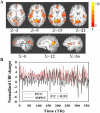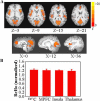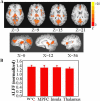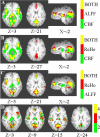Static and dynamic characteristics of cerebral blood flow during the resting state
- PMID: 19607928
- PMCID: PMC2739419
- DOI: 10.1016/j.neuroimage.2009.07.006
Static and dynamic characteristics of cerebral blood flow during the resting state
Abstract
In this study, the static and dynamic characteristics of cerebral blood flow (CBF) in the resting state were investigated using an arterial spin labeling (ASL) perfusion imaging technique. Consistent with previous PET results, static CBF measured by ASL was significantly higher in the posterior cingulate cortex (PCC), thalamus, insula/superior temporal gyrus (STG) and medial prefrontal cortex (MPFC) than the average CBF of the brain. The dynamic measurement of CBF fluctuations showed high correlation (functional connectivity) between components in the default mode network. These brain regions also had high local temporal synchrony and high fluctuation amplitude, as measured by regional homogeneity (ReHo) and amplitude of low-frequency fluctuation (ALFF) analyses. The spatial pattern of the static CBF correlated well with that of the dynamic indices. The high static and dynamic activities in the PCC, MPFC, insula/STG and thalamus suggest that these regions play a vital role in maintaining and facilitating fundamental brain functions.
Figures






References
-
- Aguirre GK, Detre JA, Zarahn E, Alsop DC. Experimental design and the relative sensitivity of BOLD and perfusion fMRI. Neuroimage. 2002;15:488–500. - PubMed
-
- Beckmann CF, Smith SM. Probabilistic independent component analysis for functional magnetic resonance imaging. IEEE Trans.Med.Imaging. 2004;23:137–152. - PubMed
-
- Biswal B, Hudetz AG, Yetkin FZ, Haughton VM, Hyde JS. Hypercapnia reversibly suppresses low-frequency fluctuations in the human motor cortex during rest using echo-planar MRI. J.Cereb.Blood Flow Metab. 1997a;17:301–308. - PubMed
Publication types
MeSH terms
Substances
Grants and funding
LinkOut - more resources
Full Text Sources

